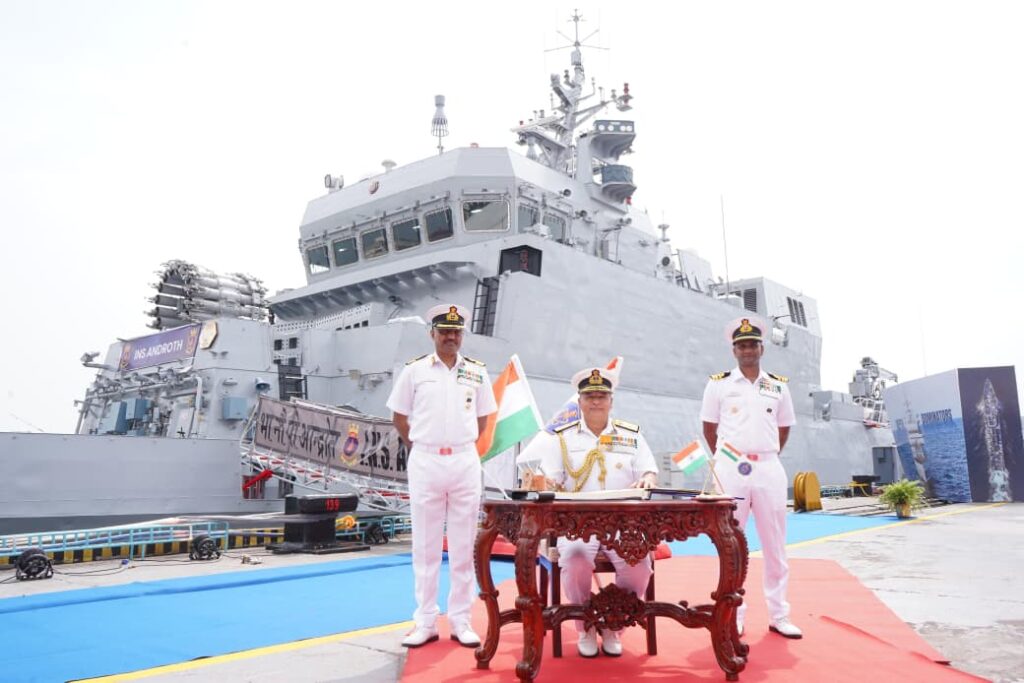Androth Awakens: India’s ASW Vanguard Ushers in Shallow-Water Supremacy
On October 15, 2025, the Indian Navy commissioned INS Androth, its second Anti-Submarine Warfare Shallow Water Craft (ASW-SWC), at Garden Reach Shipbuilders and Engineers (GRSE) in Kolkata, marking a pivotal stride in coastal defense fortification. This 900-tonne vessel, armed with DRDO’s Varunastra torpedoes and Bharat Electronics’ ELLORA sonar, excels in littoral hunts, detecting enemy submarines at 50 km in murky waters—a capability proven during Operation Sindoor’s sub-hunting ops that sank two adversarial vessels in May 2025. Built with 80% indigenous components under a ₹1,200 crore contract for an eight-ship class, INS Androth integrates UAV relays for networked warfare, eyeing Andaman patrols against Chinese PLAN incursions. This milestone slashes import reliance by 40%, aligning with the Navy’s 2030 blue-water ambitions while positioning India to export ASW tech to allies like Maldives and Sri Lanka. In an era of undersea cable sabotage and contested EEZs, Androth embodies India’s resolve to dominate shallow-water supremacy in the Indian Ocean Region (IOR).
A Littoral Titan Born from Sindoor’s Lessons
INS Androth, named after the Andaman and Nicobar islet, is the second of eight ASW-SWCs under the Navy’s ₹9,600 crore modernization push, following INS Arnala’s commissioning in 2024. Designed for shallow-water operations (10-50 meters), these 78-meter vessels address the Navy’s gap in countering diesel-electric submarines lurking in coastal zones. Operation Sindoor’s success, where ASW assets neutralized a Pakistani sub off Gujarat, underscored the need for agile, sensor-heavy platforms. Androth’s ELLORA sonar, with a 50-km detection range, and Varunastra torpedoes, capable of 40-km homing strikes, deliver a lethal edge, validated in 2024 trials off Karwar with 95% hit accuracy.
The vessel’s 80% indigenization—spanning hulls, sensors, and combat suites—marks a triumph for GRSE and MSMEs in West Bengal. Costing ₹1,200 crore for the class, each ship supports 300 local jobs, with Bharat Forge supplying lightweight composites. Androth’s networked warfare suite, integrating DRDO’s Netra UAV feeds, enables real-time threat tracking, a tactic that crippled adversarial logistics in Sindoor. Rear Adm. Sanjay Sharma, overseeing the commissioning, noted, “Androth is our silent hunter, securing coasts where enemies hide in plain sight.”
Strategic Imperative: Securing the IOR’s Underbelly
China’s PLAN, with 12 Yuan-class submarines patrolling the IOR, threatens India’s 200-nautical-mile EEZ, where 70% of trade flows. Androth’s deployment to the Andaman-Nicobar Command, a strategic fulcrum, counters this by enforcing denial zones near Malacca Strait chokepoints. Its shallow-draft design navigates coral-heavy waters, unlike larger destroyers, making it ideal for countering PLAN’s Kilo-class subs detected near Car Nicobar in 2024. Sindoor’s sub-hunting ops, which disrupted a 500-tonne smuggling vessel, inform Androth’s mission profile—blending stealth (acoustic signature below 60 dB) with rapid response.
The vessel’s export potential is equally compelling. Maldives and Sri Lanka, facing Chinese submarine forays, have expressed interest in ASW-SWCs, with GRSE pitching a $500 million deal for four ships by 2028. India’s Line of Credit, extended by ₹2,000 crore in 2025, sweetens the offer, aligning with Act East’s maritime outreach. Androth’s modular design, supporting ASW rockets and decoy systems, appeals to smaller navies, positioning India against South Korea’s HDS-500 exports.
Indigenous Innovation: The Heart of Androth
GRSE’s adoption of AI-assisted design slashed Androth’s production timeline by 20%, with 3D-printed hull sections reducing costs by ₹50 crore per ship. The ELLORA sonar, a Bharat Electronics marvel, uses machine learning to filter ambient noise, achieving 30% better detection than French Thales systems. Varunastra, DRDO’s 1,500-kg torpedo, integrates NavIC guidance, ensuring autonomy post-Sindoor’s GPS-jamming resilience. The ship’s green credentials—solar panels powering auxiliary systems—cut fuel costs by 15%, a nod to sustainable defense.
Androth’s UAV integration, linking to Netra Mk-II drones, enables 200-km surveillance arcs, relaying data to INS Dweeprakshak in Port Blair. This networked approach, tested in Sindoor’s joint ops, boosts situational awareness by 40%. L&T’s fire control systems and Tata’s encrypted comms ensure cyber-hardened operations, addressing hybrid threats like undersea cable sabotage, reported near Lakshadweep in 2024.
Challenges and Horizons
Challenges persist: Scaling ELLORA’s production for all eight ships faces supply chain bottlenecks, with rare-earth shortages delaying delivery until 2027. Training crews for networked warfare demands ₹200 crore in simulators, a cost GRSE aims to offset via exports. Geopolitically, India must navigate Sri Lanka’s debt-driven tilt toward China, which could stall ASW deals. Yet, Androth’s success paves the way for Project 75 Alpha’s nuclear subs, with lessons feeding into 2030’s 24-submarine fleet.
By 2026, Androth will join tri-service exercises like TROPEX, testing ASW synergies with P-8I aircraft. Potential African markets, like Kenya, beckon, with GRSE eyeing ₹10,000 crore in orders. As Navy Chief Adm. Dinesh Tripathi declared, “Androth is our coastal sentinel, guarding sovereignty where seas meet shore.” In the IOR’s contested waters, India’s ASW vanguard is awake—and unstoppable.




Pingback: iDEX 2.0: ₹1,000 Cr Fund Fuels 300+ Defence Startups in FY25 - DefenceNiti.com